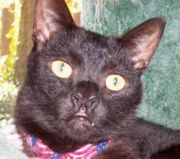“Hair lips” and “cleft palate” are a genetic disorder common to all animals, including the cat.

It is caused by failure of closure of the palatal mucoperiosteum during fetal development in utero. The deficit in the hard palate can range in severity from mild to severe. There may be loss of tissue in the hard palate as well as affecting dentoalveolar structures, causing dental malformations, fluid leakage into the nasal passage via oronasal fistulas during feeding and inhalation pneumonia in severe cases[1].
Both cleft palate and hair lip can occur concurrently and there there is some evidence for a hereditary link, as are other congenital defects such a cryptorchidism (retained testicle) and flat chest syndrome (kittens). In the lethal form of cleft palate, the entire soft and hard palates may be absent or nearly so. In the mild form, there are small holes in the palates that can be surgically repaired. There are many stages intermediate between these extremes. Complications include chronic rhinitis[2] and ear infections[3]. Tube feeding is necessary if kittens with repairable clefts are to survive.
There appears to be no breed predisposition although it appears common in round-headed cats such as ultra-type Persian and Ragdoll cats. A British kitten was reported with cleft palate and bifurcation of rostral mandible in association with conjoined twins[4]. Dietary supplements containing large concentrations of vitamin A (hypervitaminosis A) have a potential for inducing cleft palate formations in the kittens. Hypervitaminosis A has also been associated with other congenital defects such as cranioschisis, foreshortened mandible, stenotic colon, enlarged heart and agenesis of the spinal cord and small intestine[5].
Treatment in minor cases is unnecessary providing the kitten feeds normally. In cases where feeding is difficult, surgical intervention is required, although expertise is required. The standard surgical correction for most cases involves bilateral overlapping mucosal single-pedicle flaps[6], although prosthodontic appliances have been used with success in some cases[7].
In severe cases, or where surgical intervention is unavailable, euthanasia is usually warranted, due to poor quality of life.
References
- ↑ van Damme PA, Freihofer HP, Maltha JC, Kuijpers-Jagtman AM, van’t Hof MA. (1997) Three-dimensional morphometric analysis of the effects of subperiosteal palatal soft-tissue expansion in growing cats. Int J Oral Maxillofac Surg 26(1):61-67
- ↑ van den Bergh D (1998) Chronic rhinitis in a cat as a sequela to a cleft palate. Tijdschr Diergeneeskd 123(7):233
- ↑ Gregory SP. (2000) Middle ear disease associated with congenital palatine defects in seven dogs and one cat. J Small Anim Pract 41(9):398-401
- ↑ Seavers AM (2009) Monocephalus dipygus parapagus: a suspected case of complete caudal duplication in a British Blue kitten. J Feline Med Surg 11(4):330-331
- ↑ Freytag TL, Liu SM, Rogers QR, Morris JG (2003) Teratogenic effects of chronic ingestion of high levels of vitamin A in cats. J Anim Physiol Anim Nutr (Berl) 87(1-2):42-51
- ↑ Griffiths LG, Sullivan M. (2001) Bilateral overlapping mucosal single-pedicle flaps for correction of soft palate defects. J Am Anim Hosp Assoc 37(2):183-186
- ↑ Smith MM, Rockhill AD. (1996) Prosthodontic appliance for repair of an oronasal fistula in a cat. J Am Vet Med Assoc 208(9):1410-1412